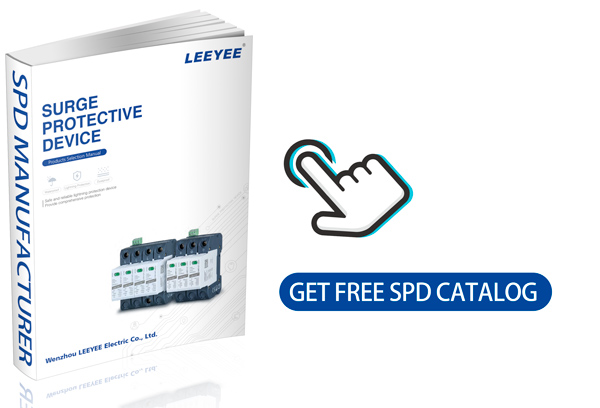When an unexpected voltage spike hits your equipment, it can instantly damage control systems, inverters, or switchgear, triggering costly downtime. How does a surge protector work to prevent such failures? The answer lies in fast-response protective devices. LEEYEE, a certified surge-protection manufacturer, provides high-speed SPDs for substation panels, solar inverters, and industrial switchboards. With response times under 25 ns and discharge capacities up to 100 kA, LEEYEE devices, certified to CE/CB/ISO9001/TUV, deliver industry-leading performance.
Keep reading to discover the detailed engineering behind surge protection.
A surge protector works by detecting over‑voltage events and instantly shunting excess energy to earth, clamping voltage to safe limits, and safeguarding connected equipment from explosive transient current.
Still unsure how components like MOVs, GDTs, and SPDs integrate into real systems? Let’s explore the real technical mechanics.

How Does a Surge Protector Work: Technical Breakdown
A surge protector, also called a Surge Protective Device (SPD), is engineered to limit transient over-voltages by switching from high impedance to low impedance when voltage thresholds are exceeded.
Key components:
-
Metal Oxide Varistor (MOV): non-linear resistor that clamps voltage; typical protection voltage 350–600 V for 275 V systems.
-
Gas Discharge Tube (GDT): activates at higher voltage, shunting large energy events.
-
Transient Voltage Suppression (TVS) Diode: high-speed response for microcircuits.
-
Series Fuse or Thermal Disconnect: isolates failed MOVs to prevent thermal runaway.
-
Status Indicator: visual flag or remote contact for maintenance.
The response sequence:
-
Voltage climbs → MOV enters conduction → voltage clamped near its Vc.
-
For high-energy surge, GDT triggers → energy voided to earth.
-
MOV cools, returns to high impedance.
Under IEC 61643-11, SPDs must react within ≤25 ns and handle In (8/20 µs) between 20–40 kA, with peak Imax up to 100 kA.
LEEYEE Product Specifications
| Parameter | Value |
|---|---|
| Rated Voltage (Uc) | 275 V AC, 600–1500 V DC |
| Nominal Discharge Current (In) | 20–40 kA (8/20 μs) |
| Maximum Discharge Current (Imax) | 100 kA (8/20 μs) |
| Response Time | < 25 ns |
| Voltage Protection Level (Up) | ≤1.5 kV |
| Standard Compliance | IEC 61643-11, EN 50539, GB18802 |
| Thermal Disconnect | Included for safe MOV failure |
| Status Indication | LED + dry contact |
These specs make LEEYEE SPDs ideal for industrial solar, data centers, and plant control panels.
Application Scenarios and Installation Guidelines
-
Power Distribution Panels: Use Type 2 SPDs at MCC/incomer with fused coordination.
-
Solar Inverter Input: Choose 1000 VDC-rated SPD with Up ≤1.8 kV, integrated GDT + MOV hybrid.
-
Signal Line Protection: Employ TVS-based (≤150 V) SPD modules.
-
Panel-level Deployments: Pair SPD with 10 kA, gG fuse for short-circuit protection.
Safety zones per IEC 60664 require coordination between short-circuit ratings and SPD’s Icc to ensure proper device operation and safety.
Maintenance & Performance Testing
-
Visual inspection: Check LED / indicator status periodically.
-
MOV monitoring: Use infrared cameras or resistance meters; replace if ΔT > 10 K or MOV resistance high.
-
End-of-life cycles: Replace units after cumulative surge exposure or 5 years.
-
Ground integrity: Ensure grounding resistance < 5 Ω in LV systems and ≤1 Ω in MV systems.
Technical error rates drop to <1% with proper installation and maintenance.
FAQs – How Does a Surge Protector Work?
1. How does a surge protector work under high-frequency spikes?
TVS diodes clamp microsecond-level spikes; MOVs handle broader transient events, providing layered protection.
2. Can SPDs fail without indication?
Yes. Thermal isolators disconnect MOVs; remote alarms or indicators must be monitored periodically.
3. How do I select response time and discharge specs?
Based on system voltage, risk of lightning (Ng value), and equipment sensitivity—follow NEC Article 285 in the U.S. and IEC principles globally.
4. Why pair SPD with a fuse?
The fuse isolates the SPD upon MOV failure to prevent secondary faults and fire hazards.
5. Where should I locate SPDs?
At distribution board, inverter input, and panel feed – staged to protect both system and downstream devices.
6. Are LEEYEE SPDs locally compliant?
Yes. There are IEC versions for EU markets, UL1449 Type 1&2 for U.S., and GB-rated devices for China.
7. How often should I test SPDs?
Conduct annual inspections, with thermal imaging and resistance testing under full load conditions.
⚠️ Professional Disclaimer
This article is for qualified power engineers and system integrators. SPD selection, grounding protocol, and surge risk coordination must comply with NEC, IEC, or local regulations and be certified by electrical professionals.
